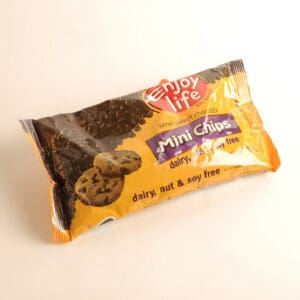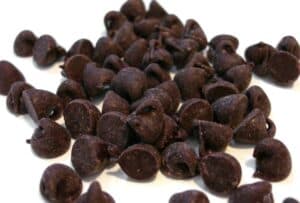When it comes to semi sweet chocolate, you’ll find that it’s a versatile and delicious option used in countless recipes. This type of chocolate is different from milk chocolate and dark chocolate, with a cocoa percentage ranging from 35% to 60%. Perfect for baking, you might often come across semi-sweet chocolate chips in cookies, brownies, or even some confections.
What sets semi-sweet chocolate apart from its counterparts like milk chocolate and bittersweet chocolate is the amount of sugar added. In comparison, milk chocolate has more sugar and a lower cocoa solid content, while bittersweet chocolate contains less sugar. Semi-sweet chocolate has a rich chocolate flavor without being overly sweet, striking a balance of cocoa solids and sugar that many people enjoy.
If you’re perusing the baking aisle or candy aisle, you’ll likely spot various brands of chocolate chips offering semi-sweet, bittersweet, and even dark chocolate options. Don’t forget to pay attention to the cocoa butter and cocoa solid content on the packaging, as it will determine the overall chocolate flavor in your recipes. With so many choices available, you can experiment and find the perfect semi-sweet chocolate to satisfy your taste buds and enhance your baking creations.
Understanding Semi-Sweet Chocolate

When it comes to semi-sweet chocolate, you may wonder how it differs from other varieties like milk chocolate, dark chocolate, and bittersweet chocolate. Well, it’s time to unravel the mystery and appreciate the unique aspects of semi-sweet chocolate!
Semi-sweet chocolate lies somewhere between milk chocolate and dark chocolate in terms of cocoa content. While milk chocolate typically contains 6-18% cocoa solids, semi-sweet possesses a slightly higher range of 12-26%. On the darker side of the spectrum, dark chocolate features an even more robust 18-72% cocoa solids.
Now let’s talk about the sugar content. Milk chocolate, as expected, has more sugar added to it, whereas semi-sweet chocolate contains less sugar, giving it a more balanced flavor and reducing the overall sweetness. This characteristic is what makes it so versatile in various recipes.
You’ll often come across semi-sweet chocolate chips in the baking aisle. They’re ideal for cookies, brownies, and other baked goods that call for a rich chocolate flavor without being overly sweet. Bakers and chocolate enthusiasts alike appreciate the equilibrium of sweetness and bitterness in semi-sweet chocolate chips.
One of the key components of semi-sweet chocolate is cocoa butter, which makes up a substantial portion of the chocolate mass and contributes to its smooth, creamy texture. Additionally, emulsifiers like soy lecithin and stabilizers may be present to prevent the cocoa butter from separating out of the chocolate.
Among the different varieties of chocolate, semi-sweet exhibits some health benefits too! High-quality semi-sweet chocolate contains a higher percentage of cocoa solids, which supply the body with beneficial antioxidants. Of course, moderation is key, as excessive consumption of any chocolate can negate potential health advantages.
Venture down the candy aisle, and you’ll notice semi-sweet chocolates come in various forms – bars, chips, chunks, and even baking discs. Pay attention to the cocoa percentage specified on the packaging, as it will help anticipate the taste: a higher cocoa percentage yields a more bitter chocolate, while a lower percentage results in a sweeter taste.
How to Store and Handle Semi-Sweet Chocolate

When it comes to storing and handling your semi-sweet chocolate, there are a few crucial steps you should follow. Proper storage not only keeps your chocolate fresh and delicious but also helps maintain its rich chocolate flavor. Here are some useful tips on how to store and handle your semi-sweet chocolate.
Storing Chocolate:
- Cool, Dry Environment: Keep your chocolate in a cool, dry place away from direct sunlight. The ideal temperature for storing chocolate is around 0/12–26°F (-34.4–26.6°C). Also, avoid temperature fluctuations as it could affect the chocolate’s quality.
- Airtight Containers: Store your chocolate in airtight containers, such as plastic bags or sealed and wrapped in aluminum foil. This will help protect your chocolate from humidity and external odors.
- Away from Strong Odors: Since chocolate can absorb odors, be sure to store it away from strong-smelling foods or household items.
Handling Chocolate:

- Keep it Dry: When working with chocolate, ensure your hands, utensils, and surfaces are clean and dry. Chocolate and water don’t mix well, so always be cautious.
- Avoid Overheating: When melting your chocolate, use gentle heat and stir continuously. Overheating can cause your chocolate to separate and become grainy or lumpy.
- Baking with Chocolate: If you’re using semi-sweet chocolate chips in your baked goods, toss them in a bit of flour before adding them to your recipes. This helps prevent the chocolate chips from sinking to the bottom of your cake or brownie.
- Best Before Dates: Pay attention to the best before dates on your semi-sweet chocolate. Although chocolate can last a long time, it’s always better to enjoy it while it’s fresh.
When you’re shopping for semi-sweet chocolate, you’ll find a variety of options in the baking aisle or candy aisle, including chocolate bars and chocolate chips. Semi-sweet chocolate contains a mixture of cocoa, sugar, and other ingredients such as soy lecithin and vanilla. The cocoa percentage usually varies between 0/12–40%, making it slightly less sweet than milk chocolate and sweeter than bittersweet or unsweetened chocolate.
To create a deliciously rich treat, you can use semi-sweet chocolate chips as a substitute in recipes that call for other types of chocolate, such as dark chocolate, sweet chocolate, or milk chocolate. Be sure to consider the difference in taste and sweetness when making substitutions.
Baking Recipes with Semi-Sweet Chocolate

When it comes to baking, semi-sweet chocolate is a versatile ingredient that can elevate your homemade treats. Whether you’re a fan of cookies, cakes, or even fudges, there’s no shortage of delicious recipes using semi-sweet chocolate. In this section, we’ll explore some popular and mouth-watering concoctions suited for different palates.
If you’re a cookie enthusiast, it’s hard to beat the classic chocolate chip cookie featuring semi-sweet chocolate chips. Not only are these cookies a perfect blend of sugar and cocoa, but they also offer a rich chocolate flavor. Want to take it up a notch? Try mixing in various nuts for added crunch and texture.
- Classic chocolate chip cookies
- Oatmeal cranberry and semi-sweet chocolate chip cookies
- White chocolate and semi-sweet chocolate thumbprint cookies
For those who prefer a creamier dessert, opt for a decadent triple chocolate cake using semi-sweet, dark, and milk chocolate in its layers and ganache. This deliciously rich treat will not only satisfy your taste buds but also impress your guests.
On the darker side of recipes, you can opt for brownies with semi-sweet chocolate chips and chunks for a fudgy, intense chocolate flavor that chocolate lovers adore. To customize your brownies, try adding ingredients like peanuts, marshmallows, or caramel sauce.
Are you pining for a healthy snack? Whip up a homemade trail mix with semi-sweet chocolate chips, nuts, dried fruits, and seeds for a convenient, energy-boosting nibble on the go. To ensure you’re enjoying the health benefits of chocolate, choose a semi-sweet chocolate with a higher cocoa percentage.
Lastly, let’s not forget the warmth and comfort of a cup of hot cocoa. Using semi-sweet chocolate chips and milk, you can create a cozy and soothing beverage seasoned with vanilla, cinnamon, or even peppermint. Top it off with whipped cream or marshmallows for an indulgent treat.
Pairing Semi-Sweet Chocolate with Wine

A marriage made in heaven: semi-sweet chocolate and wine. There’s something magical about the delightful combination of rich chocolate flavor and a perfectly paired glass of wine. But how do you find that ideal match? Fear not, because we’re here to guide you on your delicious journey.
Let’s start with the basics. Semi-sweet chocolate, falling between milk chocolate and dark chocolate on the cocoa scale, generally contains less sugar than its milk chocolate counterpart, but usually more sugar than dark chocolate. This balance makes semi-sweet chocolate a versatile choice for baking and snacking alike.
When it comes to wine pairings, you’ll want to focus on two main components: taste and sweetness. A wine high in acidity, such as champagne or sparkling wine, can work well to balance the intensity of semi-sweet chocolate chips, creating a delightful symphony on your taste buds.
If you prefer red wine, consider trying a fruity, medium-bodied wine like a Pinot Noir or a Zinfandel. These reds tend to have low to medium tannins, which work well with the rich, sweet flavors of semi-sweet chocolate. Similarly, a ruby Port or a sweet, fortified wine like Banyuls can complement bittersweet chocolate with its concentrated fruit and sugar notes.
Keep these general guidelines in mind when pairing:
- Lighter chocolates like milk or semi-sweet chocolate go well with lighter-bodied wines with bright acidity or fruitiness.
- Bitter chocolates, such as dark or bittersweet, pair best with fuller-bodied wines with robust fruit, tannin, or alcohol to match the chocolate’s intensity.
For a unique twist, don’t be afraid to experiment with pairing semi-sweet chocolate with other types of wine. Riesling, a versatile and aromatic white wine, can create an intriguing contrast when served with semi-sweet chocolate, especially when the Riesling is an off-dry or sweet late-harvest variety.
Moreover, if you’re a fan of soy lecithin-free chocolate, consider pairing it with a dessert wine, like Sauternes or Moscato d’Asti, which have indulgent notes of honey, tropical fruit, and floral aromas that can accentuate the blissful character of your chocolate treat.
Finally, don’t limit yourself to just wine! Other beverages, like hot cocoa and even full-flavored ales, can make for an exciting and diverse chocolate pairing experience. Just remember, taste is subjective; what may be deliciously rich for one person might be too sweet for another. So keep an open mind, and let your palate be your guide as you discover a world of decadent, chocolate-infused indulgence.
Health Benefits of Semi-Sweet Chocolate

Semi-sweet chocolate, with its rich chocolate flavor, is not only a delicious treat, but it also has numerous health benefits. When compared to milk chocolate, semi-sweet chocolate has less sugar and a higher cocoa percentage, which contributes to its potential health benefits. So, let’s explore some of the key advantages of indulging in semi-sweet chocolate.
Rich in Antioxidants
Dark chocolate and semi-sweet chocolate share a common trait—both are rich in antioxidants due to their higher cocoa solid content. Antioxidants can help protect your body from damage caused by free radicals and are essential for maintaining optimal health. As a result, semi-sweet chocolate chips or chunks can be a guilt-free addition to your favorite recipes.
Heart Health
Studies have shown some possible benefits of dark and semi-sweet chocolate for heart health. These chocolates contain cocoa butter, which has healthy fats that can help lower LDL (bad) cholesterol and raise HDL (good) cholesterol. Remember that moderation is key, as overconsumption may negate these health benefits.
Mood Booster
Semi-sweet chocolate contains compounds that may help improve your mood. For instance, it has phenylethylamine (PEA), which your brain produces when you feel happy or in love. PEA can encourage your brain to release endorphins, natural mood-lifting chemicals.
Low in Dairy
People with lactose intolerance or dairy sensitivities will be glad to know that semi-sweet chocolate has less dairy content compared to milk chocolate, making it a more suitable option for those who struggle with dairy products.
To get the most out of semi-sweet chocolate’s health benefits, it’s essential to select a high-quality product. Look for chocolates with a higher cocoa solid content and minimal added sugars. Some favorite brands of semi-sweet chocolate bars or chips include bittersweet chocolate and unsweetened chocolate.
In conclusion, don’t be afraid to incorporate semi-sweet chocolate into your life, whether for baking or simply as a deliciously rich snack. It offers a variety of health benefits, from antioxidant content to mood-boosting qualities. Just remember to enjoy in moderation!
Final Thoughts: Make Semi-Sweet Chocolate Your Favorite
When it comes to satisfying your sweet tooth, semi-sweet chocolate should be your go-to choice. With its perfect balance between sweet and bitter flavors, you’ll find it’s a delicious and versatile option for various recipes. Here’s why it’s time to make semi-sweet chocolate your favorite.
Semi-sweet chocolate contains less sugar compared to milk chocolate, making it a healthier option. Typically, semi-sweet chocolate ranges between 12-26% sugar, while milk chocolate varies between 6-18%. As you move towards darker chocolate offerings, you’ll find even less sugar, making it suitable for those seeking healthier alternatives within the candy aisle.
When browsing your local baking aisle, you’re likely to come across semi-sweet chocolate chips, which are a popular option for bakers. They’re perfect for adding deliciously rich chocolate flavor to your favorite cookies, brownies, and cakes. Their balance of bitter and sweet provides a tasty contrast to the other ingredients in your recipes.
For those who prefer their chocolate on the darker side, semi-sweet chocolate has cocoa percentages ranging from 35-60%. This higher cocoa percentage delivers a rich, deep chocolate flavor, elevating the taste of your homemade treats. If you’re after an even more intense flavor, bittersweet chocolate boasts a cocoa solid content of 60-85%, adding a unique twist to your baking creations.
Besides its rich flavor profile, semi-sweet chocolate also delivers potential health benefits, thanks to its cocoa solids content. Dark chocolate, in particular, has been praised for its antioxidant properties, and semi-sweet chocolate also brings these nutritious perks to the table.
Another advantage of semi-sweet chocolate is its versatility. You can find it in various forms, from chips and chunks to bars and morsels. This makes it easy to incorporate into your favorite recipes, delivering creamy, indulgent flavors, whether you’re mixing it into hot cocoa or melting it down for a smooth, chocolatey sauce.
Lastly, semi-sweet chocolate is accommodating for those with dietary preferences or restrictions. You can find options that are soy lecithin-free, gluten-free, or dairy-free. This versatility ensures that semi-sweet chocolate remains a staple in your pantry, regardless of your preferences.
In summary, make semi-sweet chocolate your favorite and elevate your baking game. Its balanced flavor, health benefits, and versatility make it the perfect choice for your sweet indulgences.
Other suggested articles:
